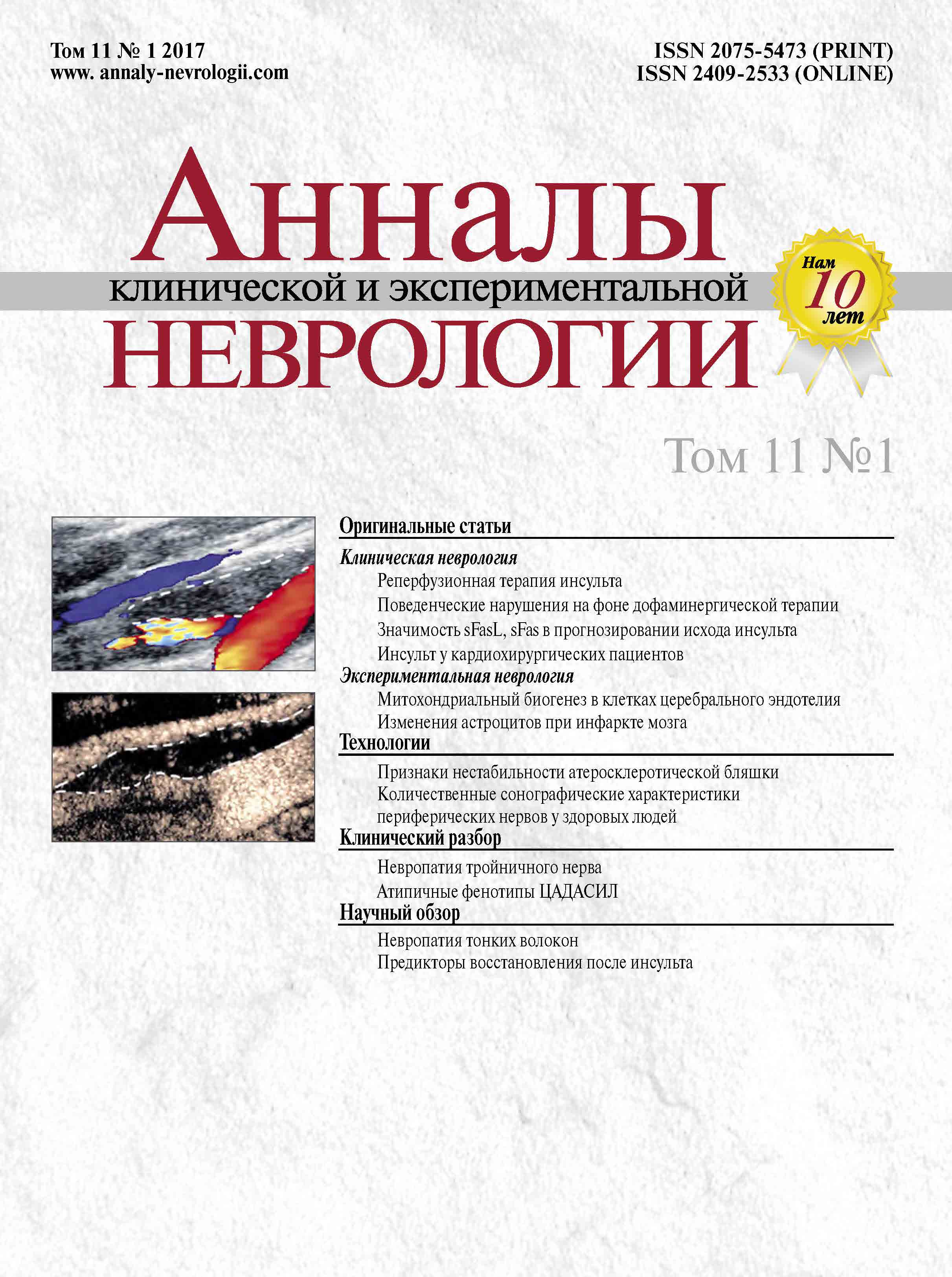Поведенческие нарушения при болезни Паркинсона на фоне дофаминергической терапии
- Авторы: Никитина А.В.1, Федорова Н.В.1
-
Учреждения:
- ФГБОУ ДПО Российская медицинская академия непрерывного последипломного образования Минздрава России
- Выпуск: Том 11, № 1 (2017)
- Страницы: 14-20
- Раздел: Оригинальные статьи
- Дата подачи: 20.04.2017
- Дата публикации: 12.05.2017
- URL: https://annaly-nevrologii.com/journal/pathID/article/view/454
- DOI: https://doi.org/10.18454/ACEN.2017.1.6149
- ID: 454
Цитировать
Полный текст
Аннотация
Введение. Болезнь Паркинсона (БП) – прогрессирующее неврологическое заболевание, в основе которого лежит дегенерация дофаминергических нейронов в компактной части черной субстанции. Наиболее эффективными в лечении этого заболевания являются дофаминергические препараты, которые могут приводить к развитию поведенческих расстройств или нарушений импульсного контроля (НИК). К НИК относят компульсивный шопинг, игроманию, гиперсексуальность, компульсивное переедание, пандинг (бесцельные повторяющиеся действия), дофаминовый дизрегуляционный синдром (ДДС).
Цель работы – выявление частоты поведенческих расстройств при БП с оценкой их влияния на показатели качества жизни и повседневной активности пациентов и их родственников.
Материалы и методы. Для определения распространенности НИК 340 пациентов с БП были подвергнуты анкетированию с помощью краткого опросника для выявления нарушений импульсного контроля – QUIP-Short. В последующий анализ были включены 60 больных БП с выявленными НИК (17% от общего числа обследованных) и 20 больных БП без поведенческих нарушений, у которых для оценки НИК, импульсивности, повседневной активности, качества жизни, тревоги, депрессии, когнитивных нарушений применялась батарея специальных тестов.
Результаты. ДДС имел место у 8% пациентов БП, пандинг – у 10%, компульсивное переедание – у 6%, гиперсексуальность – у 5%, компульсивный шопинг – у 4%, а игромания только у 1% пациентов. Показатель повседневной активности больных БП с НИК в среднем составил 60,05±9,76%, показатель качества жизни – 67,21±18,54%, причем эти значения были существенно ниже, чем у больных БП без поведенческих нарушений.
Заключение. НИК встречаются у каждого пятого больного БП на фоне дофаминергической терапии. Наиболее часто диагностируются ДДС и пандинг. Развитие НИК значительно влияет на повседневную активность больных и снижает качество жизни как больных, так и их родственников.
Об авторах
А. В. Никитина
ФГБОУ ДПО Российская медицинская академия непрерывного последипломного образования Минздрава России
Email: natalia.fedorova@list.ru
Россия, Москва
Наталия Владимировна Федорова
ФГБОУ ДПО Российская медицинская академия непрерывного последипломного образования Минздрава России
Автор, ответственный за переписку.
Email: natalia.fedorova@list.ru
Россия, Москва
Список литературы
- Golubev V.L., Levin Ya. I., Veyn A.M. Bolezn' Parkinsona i sindrom parkinsonizma.[Parkinson’s disease and parkinsonism]. Moscow. MEDpress-inform,1999. 415 p. (In Russ.)
- Litvinenko I.V. Bolezn' Parkinsona. [Parkinson’s disease]. Moscow. Miklosh,2010. 216 p. (In Russ.)
- Shtok V.N., Levin O.S., Fedorova N.V. Ekstrapiramidnye rasstroystva: [Extrapyramidaldisorders:]. Moscow. MIA, 2000. 175 p. (In Russ.).
- Evans A.H., Lawrence A.D., Potts J. et al. Factors influencing susceptibilityto compulsive dopaminergic drugs in Parkinson’s disease. Neurology; 2005: 65:1570–1574. PMID: 16301483. doi: 10.1212/01.wnl.0000184487.72289.f0.
- Evans A.H., Lees A.J. Dopamine dysregulation syndrome in Parkinson’s disease.Curr Opin Neurol. 2004; 17: 393–398. PMID: 15247533.
- Giovannoni G., O’Sullivan J.D., Turner K. et al. Hedonistic homeostatic dysregulationin patients with Parkinson’s disease on dopamine replacement therapies.J. Neurol. Neurosurg. Psychiatry. 2000; 68; 423–428. PMID: 10727476.doi: 10.1136/jnnp.68.4.423
- Lawrence A.J., Blackwell A.D., Barker R.A. et al. Prediction of punding inParkinson’s disease: result from a questionnaire survey. Mov. Disord. 2007; 22:2339–2345. PMID: 17914729. doi: 10.1002/mds.21702
- Voon V., Hassan K., Zurowski M. et al. Prevalence of repetitive and reward-seeking behaviors in Parkinson’s disease. Neurology. 2006; 67: 1254–1257.PMID: 16957130. doi: 10.1212/01.wnl.0000238503.20816.13.
- Weintraub D., Koester J., Potenza M.N. et al. Impulsive control disorders inParkinson’s disease: a cross-sectional study of 3090 patients. Arch. Neurol. 2010;67: 589–595. PMID: 20457959. doi: 10.1001/archneurol.2010.65
- Evans A.H., Katzenschlagen R., Pavior D. et al. Punding in Parkinson’s disease:its relation to the dopamine dysregulation syndrome. Mov Disord. 2004; 19:397–405. PMID: 15077237. doi: 10.1002/mds.20045.
- Lees A.J. The dopamine dysregulation syndrome. Mov Disord. 2008; 23:1332. doi: 10.1002/mds.22147.
- Lawrence A.D., Evans A.H., Lees A.J. Compulsive use of dopamine replacementtherapy in Patkinson’s disease: reward systems gone awry? Lancet Neurol.2003; 2: 595–604. PMID: 14505581 doi: 10.1016/S1474-4422(03)00529-5.
- Kirsch P., Schienle A., Stark R. et al. Anticipation of reward in a nonaversivedifferential conditioning paradigm and the brain reward system: an event-relatedfMRI study. Neuroimage. 2003; 20: 1086–1095. PMID: 14568478. doi: 10.1016/S1053-8119(03)00381-1.
- Evans A.H., Strafella A.P., Weintraub D., Stacy M. Impulsive compulsivebehaviors in Parkinson’s disease. Mov Disord. 2009; 24: 1561–1570. PMID: 19526584. doi: 10.1002/mds.22505.
- Cools R. Dopaminergic modulation of cognitive function-implications forL-DOPA treatment in Parkinson's disease. Neurosci Biobehav Rev. 2006; 30:1–23. PMID: 15935475. doi: 10.1016/j.neubiorev.2005.03.024.
- Weintraub D., Hoops S., Shea J.A. et al.Validation of the questionnaire forimpulsive-compulsive disorders in Parkinson’s disease. Mov. Disord. 2009; 24:1461–1467. PMID: 19452562. doi: 10.1002/mds.22571
- Hoehn M.M., Yahr M. Parkinsonism: onset, progression, and mortality.Neurology. 1967; 17: 427–442. PMID: 6067254.
- Fahn S., Elton R.L., and members of the UPDRS Development Committee.Unified Parkinson’s disease rating scale. In: Fahn S., Marsden C.D., Calne D.,Goldstein M., eds. Recent developments in Parkinson’s disease. Florham Park:Macmillan Healthcare Information, 1987: 153–163.
- Plutchik R., Van Praag H. The measurement of suicidality, aggresivity andimpulsivity. Prog. Neuropsychopharmacol. Biol. Psychiatry. 1989; 13: S23–S34.PMID: 2616792.
- Weintraub D.m Siderowf A.D., Potenza M.N. et al. Association of dopamineagonist use with impulsive control disorders in Parkinson’s disease.Arch Neurol. 2006: 63; 969–973. PMID: 16831966. doi: 10.1001/archneur.63.7.969.
- Diagnostic and Statistical Manual of Mental Disorders, Version IV (DSMIV).Washington, DC: American Psychiatric Association, 1994. 884 p.
- McElroy S.L., Keck P.E., Pope H.G. et al. Compulsive buying: a report of 20cases. J. Clin. Psychiatry. 1994; 55: 242–48. PMID: 8071278
- Herzog J., Valkmann J., Krack P. et al. Two-year follow-up of subthalamicdeep brain stimulation in Parkinson's disease. Mov. Disord. 2003; 18: 1332–1337.PMID: 14639676. doi: 10.1002/mds.10518.
- Pontone G., Williams J.R., Bassett S.S., Marsh L. Clinical features associatedwith impulse control disorders in Parkinson’s disease. Neurology. 2006; 67:1258–1261. PMID: 17030761. doi: 10.1212/01.wnl.0000238401.76928.45.
- Lee J.Y., Kim J.M., Kim J.W. et al. Association between the dose of dopaminergicmedication and the behavioral disturbances in Parkinson disease. ParkinsonismRelat. Disord. 2010; 16: 202–207. PMID: 20018549. doi: 10.1016/j.parkreldis.2009.12.002.
Дополнительные файлы









